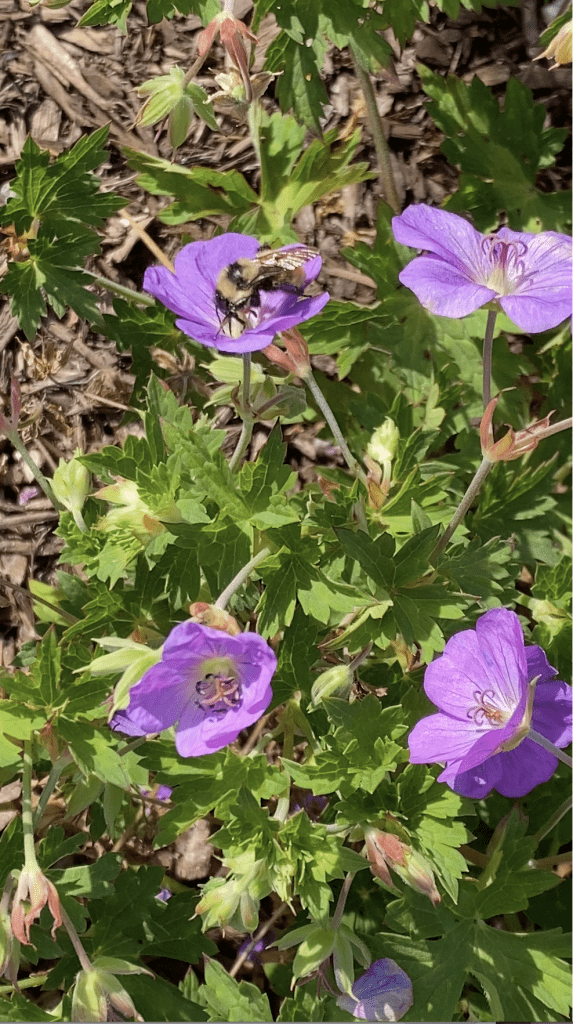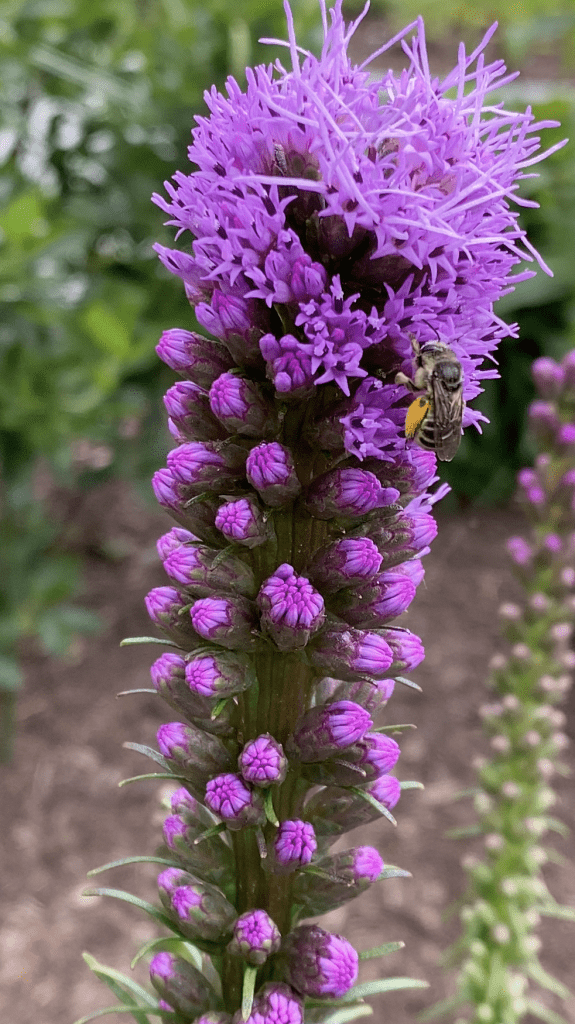Welcome back to Part Two of the BEST Native Perennials for NY, CT & NJ. These are often our go-to plants (provided the right site conditions!) because they all contribute majorly to the landscape ecology. All of these selections are regionally native plants that attract pollinators, birds and/or beneficial insects. Many of these native perennials also perform extra ecosystem services like absorbing excess rainfall, filtering out pollutants in the soil & water, stabilizing soil from erosion, and sequestering greenhouse gases. If you missed out on Part One of our Favorite Native Perennials, get caught up on our previous blog.

New York & New England Aster
Symphyotrichum novi-belgii & symphyotrichum novi-angilae
NY Aster (first photo) is 2-4’ tall and more compact in form; NE Aster is 2-5’ tall.
Dry to moist, lean soil is ideal for both. Full sun (for more blooms) to part shade. NY Aster leaves are smooth, compared to hairy New England Aster. Flower color is also paler blue/purple/pink.
Both bloom late summer thru fall & are important late-season pollen / nectar sources!

Douglas Tallamy ranks Asters as the second most important herbaceous plant for Lepidoptera! Attracts butterflies including the Pearl Crescent and Silvery Checkerspot, among others.
Both flowers are absolute magnets for native bees & honeybees. Swipe for video! Syrphid flies — natural predators of aphids, and pollinators themselves — area also attracted to Asters.
NY Aster is naturally found along the coast at lower elevations. NE Aster is found in fields, along roadsides, in woodlands and savannas.
All parts of the aster — roots leaves and flowers — were used in medicinal ways by Native American tribes. Flowers and foliage were burned for use in sweat lodge ceremonies (Inipi). Tea was drunk for earaches, stomach aches, congestion and fever. Flowers were also smoked and used as a snuff.

Anise Hyssop
Agastache foeniculum
Agastache is incredibly floriferous for many weeks AND low-maintenance (our fav combo!). The tall flower spikes make it great for the rear of a garden bed; we love combining with native ornamental grasses! Plant Agastache in your garden and let the locals feast!
2-4’ Tall
Full sun to part shade. Dry to average soils. Naturally found in prairies, dry upland forests, meadows and disturbed areas. Native from the eastern US, west to Colorado and south to Kentucky.
Blooms June to September.
Attracts: hummingbirds, monarch butterflies, swallowtails, native bees, and honey bees.
Fast-growing member of the Mint family (Lamiaceae)
Foliage is fragrant, similar to licorice / star anise (making it deer resistant!). Agastache has several culinary applications. Leaves can be made into a fragrant tea or jelly. Seeds are often added to baked goods. Leaves can be incorporated into salads.
Traditionally, an tea or infusion of Agastache leaves was used to treat fevers and colds.

Lupine
Lupinus spp.
So many beautiful and unique features to this native perennial! Lupine is one of those plants that could never flower and would still look amazing in your garden.
1-2’ Tall
Blooms June – July
Full sun (best) to part shade. Well-drained, lean, dry to medium soils. Naturally found in prairies, meadows, coastal sandy soils, and dappled woodlands. Lupine is an early succession species, meaning it is quick to colonize disturbed environments.
Member of the Pea / Legume family (Fabaceae), meaning Lupines fix nitrogen in the soil! As such, they are great companion plants to “heavy feeders” in a vegetable garden like cucumbers, squash, broccoli & cabbage.
Flower spikes can be up to 8” tall and open successional from the the bottom. Color ranges from purple to pink and red.
Beautifully distinctive palmately compound foliage (leaflets radiate around a single point) is also superhydrophobic. Instead of absorbing droplets of water, they sit atop the leaves like glistening orbs.
Once turning to seed, the pea-shaped seed pods create a lovely rattling sound in the wind!
Attracts BEES including bumble bees, eastern carpenter bees & honey bees.
BUTTERFLIES that feed on Lupine include Black Swallowtails, Clouded Sulphurs and the endangered Karmer Blues, for which Lupine is a host plant!
Other pollinators of Lupine: ants, beetles & thrips. Hummingbirds are known to feed on the nectar.
Lupines have a taproot and should not be transplanted. However, this makes them excellent plants for erosion control.
No recommended medicinal uses for Lupine due to its toxic & potentially fatal alkaloid D-lupanine. Some Native American tribes did consume a Lupine tea to treat nausea and hemorrhaging.
Note: Lupinus perennis is the wild lupine native to the east coast. Lupinus polyphyllus, Large Leaf Lupine, is native to the northwestern US. In some areas, like Maine, L. polyphyllus is crowding out the regional native with its aggressive colonization. Although both are valuable to pollinators & for soil conservation, choose the endangered L. perenniswhenever possible for Northeast landscapes! It is estimated that L. perennis wild populations have declined by 90% since 1900.

Geranium
Geranium maculatum
There is no better front border native perennial than Geranium! Interesting foliage, LONG bloom time, fills in quickly, and attracts tons of beneficial insects & pollinators. Need we say more?
1-2’ Tall
Full sun to part shade. Naturally grows in mesic deciduous forests, meadows, savannas, and stream banks. Average soils. Drought-tolerant.
‘Rozanne’ is a well-loved cultivar (pictured) that has an incredibly long bloom time (June – October!!) and violet colored blossoms.

ATTRACTS:
Beneficials: syrphid flies, lacewings, ladybugs and parasitic wasps. (All natural predators to garden pests, and essential to attract in an organic landscape!)
Bees: bumblebees, mason bees, halictid bees, android bees, namadine cuckoo bees, miner bees & more.
Butterflies & Moths: skippers
Other Pollinators: ants, beetles, March flies
Songbirds eat the seeds in fall

Geraniums depend on insect pollination. Once achieved, seeds are produced in a fruit and flung into the landscape via “explosive dispersal.” Essentially catapulted from flower to soil. Seeds have a tail shape that drives them into the soil for germination.
Foliage is palmately compound and deeply cut. In fall it turns a lovely red to yellow.
Native Americans employed geraniums to treat diarrhea, wounds, and sores. Geraniums contain tannic and gallic acids that work as an astringent, helping blood to clot.

Blazing Star
Liatris spicata
What’s not to love? Huge flower spikes up to 2.5’ long, delicate grass-like foliage, and sturdy stems that look great thru fall and winter. And that’s just the aesthetics!
3-4’ Tall
Blooms in August – September
Liatris has unique phytoremediation properties. It can grow in cadmium contaminated soil and actually uptakes the heavy metal and stores it in its tissues as a non-toxic compound! A great option for remediation projects.
Full sun preferred but tolerates part shade. Well-drained soil is best but can also withstand moisture — L. Spicata’s other common name is Marsh Blazing Star. It is naturally found in lowland prairies and is native to Eastern & Central US. L. Spicata is a good option for a rain garden!
Butterflies frequent Liatris including monarchs, swallowtails, skippers, and eastern commas.
Native bees (bumble bees, leaf-cutters), beetles and hummingbirds also visit Liatris for nectar, and songbirds will eat the seeds in fall.
Cherokee tribes used Liatris to treat pain, digestive issues, congestion and as a stimulant.

NEW YORK IRONWEED
Veronia noveboracensis
This native perennial holds a special play in our hearts — it “volunteered” into Jay’s landscape from the adjacent wetland in 2015 when they converted their rear lawn to garden, and has supported a wealth of wildlife ever since.
4-6’ tall, but can grow up to 8’!
Blooms July to September, 6 weeks!
NY Ironweed is naturally found in low-lying prairies, grasslands, dappled woodlands, disturbed areas. It prefers wet/moist soils but can tolerate drought. Full sun to part shade.
Veronia is quick to spread via rhizomes and grows quickly. We often find ourselves “editing” this tallboy out of the front of garden beds and in walkways, but it makes a fabulous rear border and has incredibly strong stems that don’t require staking (unlike most tall perennials!).

A great plant for meadows, larger naturalized gardens, and erosion control projects.
ATTRACTS an abundance of pollinators including: monarchs, swallowtails, fritillaries, painted ladies, skippers, native bees and beneficial insects. Songbirds will eat the seeds in fall.
Master designer Piet Oudolf lists NY Ironweed ‘Iron Butterfly’ as one of his *Must Have Plants* — he has planted it en masse on the NYC’s Highline and in Chicago’s Lurie Garden.

Ironweed has a host of traditional medicinal applications. Native Americans used it to treat stomach ulcers, pain from childbirth, hemorrhaging and for tooth pain.
Stay tuned for Part Three of our Favorite Native Plants – Perennials Edition. Coming soon!
Green Jay Landscape Design
Where Design Meets Ecology
914-560-6570